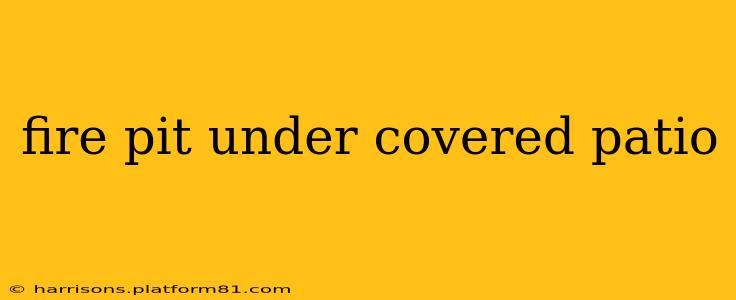Dreaming of cozy evenings under your covered patio, warmed by the crackling flames of a fire pit? It's a picture of idyllic relaxation, but achieving this requires careful planning and consideration for safety. This comprehensive guide will help you navigate the process, addressing common concerns and providing expert advice to create your perfect outdoor oasis.
Is it Safe to Have a Fire Pit Under a Covered Patio?
This is the most crucial question, and the answer is: it depends. The safety of a fire pit under a covered patio hinges on several factors, primarily the materials of your patio cover, its construction, and the type of fire pit you choose. We'll delve into these specifics later. However, improperly installed or used fire pits can pose significant risks, including fire hazards, smoke inhalation, and carbon monoxide poisoning. Therefore, thorough planning and adherence to safety regulations are paramount.
What Kind of Fire Pit is Best for a Covered Patio?
Choosing the right fire pit is essential for safety and enjoyment. Several options exist, each with its own pros and cons:
-
Propane Fire Pits: These offer the cleanest and safest option for covered patios. They produce minimal smoke and ash, and the flame is easily controlled. However, they require a propane tank, which needs regular refilling.
-
Natural Gas Fire Pits: Similar to propane, natural gas fire pits provide clean burning and easy control. They require a gas line connection, which might involve professional installation.
-
Wood-Burning Fire Pits: These offer a more traditional, rustic ambiance. However, they produce significant smoke and ash, posing a considerable risk under a covered patio. Wood-burning fire pits are generally NOT recommended for covered patios unless specific safety measures are implemented (discussed below).
-
Electric Fire Pits: These are a safe and convenient option, producing no smoke or ash. They offer a realistic flame effect without the actual fire hazards but can be less aesthetically pleasing than other options to some.
What are the Safety Precautions for a Fire Pit Under a Covered Patio?
Regardless of the fire pit type, several safety precautions are crucial:
-
Adequate Ventilation: Ensure your patio cover has sufficient ventilation to allow smoke and gases to escape safely. Consider the size and location of vents or open areas.
-
Fire-Resistant Materials: The patio cover and surrounding materials must be fire-resistant or non-combustible. Avoid materials like wood or fabrics that can easily ignite. Check local building codes for specific requirements.
-
Proper Distance: Maintain a safe distance between the fire pit and any flammable materials, including the patio cover, furniture, and plants.
-
Spark Arrestor: For wood-burning fire pits (if used), a spark arrestor is essential to prevent embers from escaping and causing a fire.
-
Smoke Detectors: Install working smoke detectors inside and outside the covered area to detect any early signs of fire.
-
Carbon Monoxide Detector: Carbon monoxide is a colorless, odorless gas produced by incomplete combustion. A carbon monoxide detector is crucial, particularly when using gas or wood-burning fire pits.
-
Fire Extinguisher: Keep a fire extinguisher readily available and know how to use it.
How Much Clearance Do I Need Between the Fire Pit and the Patio Cover?
The required clearance varies depending on your local building codes and the type of fire pit. However, a general rule of thumb is to maintain at least 10-12 feet of vertical clearance between the top of the fire pit and the patio cover. Always consult with a qualified professional to ensure adequate safety.
What are the Building Codes and Regulations for Fire Pits Under Covered Patios?
Building codes regarding outdoor fireplaces and fire pits vary significantly by location. Before installing a fire pit, check with your local building department to determine the specific regulations in your area. Failure to comply with these regulations can result in fines or even the removal of the fire pit.
Can I Build a Fire Pit Under My Covered Patio Myself?
While some people attempt DIY fire pit installations, it's generally recommended to consult a professional, particularly when installing under a covered patio. Improper installation can lead to serious safety hazards. A professional can ensure compliance with building codes and recommend the safest and most effective design for your specific situation.
By carefully considering these factors and prioritizing safety, you can create a beautiful and functional fire pit area under your covered patio, enhancing your outdoor living experience for years to come. Remember, safety should always be your top priority.
